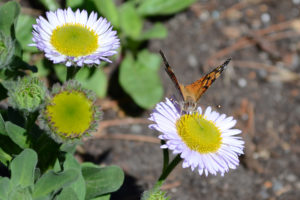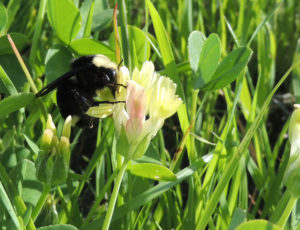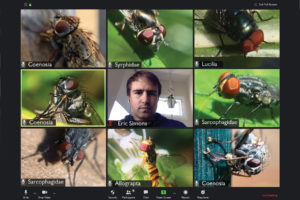In 2009, Celeste Ets-Hokin began gardening for native bees on a small plot at Lake Merritt in Oakland with the Alameda County Master Gardeners. The space was small, so at first she chose just five plants to work with. Although they were an unusual sounding bunch — seaside daisy (Erigeron glaucus), gumplant (Grindelia hirsutula), tansy leafed phacelia (Phacelia tanacetifolia), blanket flower (Gaillardia), bog sage (Salvia uliginosa) — she soon had a new name for the collection: “winning plants.” Wild bees began eagerly visiting the little garden, and over the next three years her garden grew, along with Ets-Hokin’s interest in sharing what she was learning.
In 2012, Ets-Hokin transitioned from her gardening efforts at the Lake Merritt plot to a technological collaboration. Her new iPad app, Wild Bee Gardens, draws on the knowledge of native bee experts like Dr. Gordon Frankie and Dr. Claire Kremen of UC Berkeley, and Dr. Robbin Thorp of UC Davis, to bring native bee conservation and gardening into the digital realm. The app provides an extensive reference tool for city dwellers to create their own residential bee gardens and outlines the increasing necessity of supporting native bees and their pollinating services.
Inspired by Kremen’s work to support native bees, Ets-Hokin says native bees can take on the pollinating work of the declining honeybee. Native bees were doing the work of pollinating long before the European honeybee came onto the industrial agriculture scene, of course, and Kremen’s work shows they can pollinate food crops. But to do so, they need access to natural habitats.
With the help of the Wild Bee Gardens app, city dwellers can take part in nurturing these habitats. Retaining patches of natural habitat in places that can’t be farmed attracts native bee pollinators. “As natural areas are steadily diminished,” Ets-Hokin writes in the app’s introduction, “we are discovering that our residential gardens can provide valuable habitat for many bee species.”
What does a wild bee garden look like and what’s the best way to begin creating your own? According to Wild Bee Gardens, “the best bee gardens are a bit on the wild side.” The app outlines a number of suggestions when starting your own, including:
- Provide forage: A nesting female bee will visit anywhere from 1,000 to 2,000 flowers to collect enough pollen and nectar to create the food store for a single offspring. So one of the best ways to first attract wild bees to your garden is to provide a wide variety of food. Early and late bloomers benefit miner, digger and mason bees, while newly crowned bumblebees feed heavily in late summer and early fall before winter hibernation. Diverse flower types encourage a variety of bees, which have different tongue lengths. And native plants and native bees have evolved together, and are best suited to each other.
- Provide A Nest: Bees, too, need a place to live. Even benign neglect will help ground-nesting bees – 70 percent of North American natives prefer areas of undisturbed, bare ground. But if you want to take a more active approach, the other 30 percent nest in wood tunnels or other cavities. The app suggests methods for creating both wood and artificial tunnels.
Home gardens that attract wild bees not only reap the benefits of their pollinating services, Ets-Hokin says, but can also become educational grounds to learn about local ecosystems and plants.
The Wild Bee Gardens app profiles 26 genera of native bees likely observed in North American gardens. The app also offers cross-referencing, via electronic links, of specific North American native bee genera with their preferred forage plants.
Attracting native bees to residential gardens creates a patchwork of natural habitat for wild bee neighbors amidst our urban infrastructure. Inviting these bees into the city reveals a world of fancifully striped and purple-winged creatures that were just waiting for a place to nest.
Ets-Hokin’s home garden in Oakland offers a glimpse into the beauty of playing host to wild bees beyond the yellow and black bumble. One native, the sweat bee, hovers with big spotted eyes, cloaked in metallic green. “Build it and they will come,” Ets-Hokin says.
The Wild Bee Gardens app is available for iPads through the app store, and will be available for iPhone late this summer.





